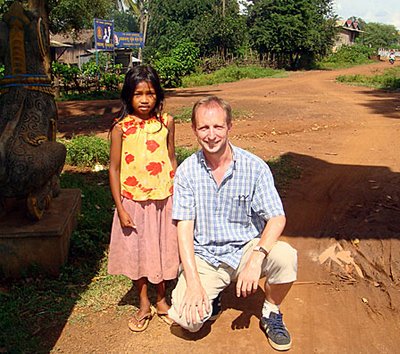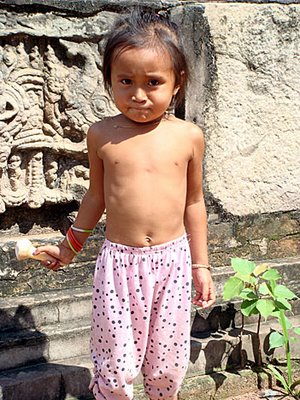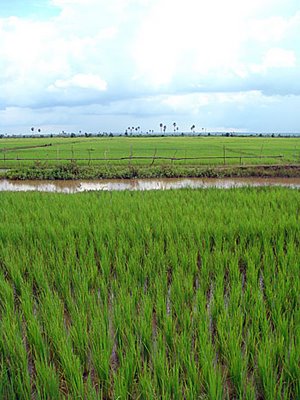Highs and lows
On any exploratory trip into the Cambodian countryside there's always likely to be some high and some lows. More often they are full of highs and fortunately few of the latter. For the longest trip of my recent visit to Kompong Cham, Sophoin drove the moto, whilst I carried the map and kept look-out for anything of interest. Our destination was the northern reaches of the province, initially alongside the west bank of the Mekong River and then further west into the rubber plantation area and back home again. On the agenda, were a few archaeological sites and two genocide memorials.
The popular site at Han Chey was our first target though we stopped off to see the colourful murals at Wat Kean Chrey Krov and the wooden ceiling and pillars at Wat Mony Rotana en route. A couple of kilometres before we got to Han Chey, which I have covered extensively in previous postings and which is well worth the 20kms trip north from Kompong Cham city, we asked around for Prasat Kuk Lvea and were pointed to a large clump of bushes and trees, which on closer inspection revealed a fairly substantial brick tower that had seen better days. There were no carvings to be seen, the roof had caved in and it was almost impossible to photograph, so we moved onto Han Chey, which is far more photogenic and cared for. There's lots to see at Phnom Han Chey and the crowds that were celebrating P'chum Ben made it an extra special visit for me. An hour later we were on our way north, stopping off at Wat Ratanak Reangsey where a group of boys made me laugh with their kung-fu impressions but suffered our first disappointment when we located Phnom Monti and despite scrabbling around in the undergrowth on top of the small mound, I could find no trace of the alleged three ruined brick towers, next to the large reclining statue of Buddha. Nearby, Wat Stung Trang should've housed our first genocide memorial but the achar, or laymen, at the pagoda told us it had been dismantled many years before and the skulls and bones of the deceased re-buried. They showed us the building which had been used as the prison, and the site was believed to have contained more than 20 large pits, lying to the west of the pagoda, housing in excess of 5,000 victims. Either side of the pagoda's vihara were two large stupas erected early in the last century, one of which was sat on the laterite foundations of something much older.
Stung Trang is a sleepy rest-stop on the banks of the Mekong River, 33kms from Kompong Cham and we struggled to find anywhere to eat, settling for a plate of fried pork in a stall next to the Lycee and opposite the scruffy market. There was nothing else on the menu. We turned inland and headed west towards the district of Chamkar Leu. Suitably refreshed, it was a hot day so we stocked up with bottled water and called into the colourful Wat Sovannakiri Meak as we passed by half a dozen bridges under repair and at 2pm, reached our next target, Wat Sopheas, 3kms off the main road. We knew it was there as two gigantic loudspeakers were blasting out Khmer music at a decibel level to hurt your eardrums at 100 metres. Unfortunately, the carvings I wanted to see were much too close to the speakers for comfort. The music was part of the pagoda's P'chum Ben celebrations and had already attracted quite a crowd, all of whom quickly perked up when I arrived in their midst. Wat Sopheas had been the site of a brick temple in Angkorean times but that had long gone and the remaining evidence was four lintels, an eroded stele and some sandstone blocks behind the pagoda. My interest in the lintels aroused the curiosity of the younger children who crowded around me but all ran away when I asked them to pose, except one brave little girl. The lintels and stele had been cemented into a water-collection tank and were pre-Angkorean and more specifically in the Sambor Prei Kuk style from the first half of the 7th century with inward facing makaras, four arches and three medallions, the central one carved with Indra on airavata. One of the lintels was different from the rest but hard to photograph as a concrete seat had been erected in front of it, and the figure in its center was badly eroded. The inscribed stele was impossible to make out and had suffered from the ravages of time. I spotted a couple of Neak Ta as we were leaving and whilst I took a photo, I saw eight year old Kove in the corner of my eye, as she ran from the pagoda to say hello and pose for a picture, not afraid of the barang in the slightest. She was so adorable.
Disappointment was to follow when we called into Wat Po Preng in Veal village, the supposed site of another genocide memorial erected to honour the victims of the Khmer Rouge regime. Located next to the forest of Trapeang Khna where scores of small graves had held the corpses of over 10,000 people, the laymen told us it had been demolished years before, but they did show us a shrine which housed a very worn and indistinct lintel and a large moonstone. We carried onto Wat Speu but again were out of luck as the achar explained that the brick temples had disappeared and nothing remained at the pagoda. Also a memorial hut with victims' bones had been erected on the site but it too was long gone. As we were leaving the pagoda, I spotted a sandstone lintel sitting under a tree, next to a large lotus flower bud in laterite and a couple of old seima stones. The lintel was 7th century and most likely Prei Kmeng in style but it began to rain heavily and stopped any further searching of the area as we sheltered from the downpour. It was after 4.30pm and we decided to call it a day. We bought a couple of plastic raincoats in gaudy yellow and pink, braved the rain and made a beeline for Kompong Cham, passing through Chamkar Leu at speed and whizzing past the extensive rubber tree plantations that the area is famous for. We arrived back in the city at 6pm under the cover of darkness, the raincoats had done their job well and we stopped for a bite to eat at a small eatery near the main roundabout. Our trip had a mixture of highs and lows but for me, any trip into the Cambodian countryside will always be a success.
The popular site at Han Chey was our first target though we stopped off to see the colourful murals at Wat Kean Chrey Krov and the wooden ceiling and pillars at Wat Mony Rotana en route. A couple of kilometres before we got to Han Chey, which I have covered extensively in previous postings and which is well worth the 20kms trip north from Kompong Cham city, we asked around for Prasat Kuk Lvea and were pointed to a large clump of bushes and trees, which on closer inspection revealed a fairly substantial brick tower that had seen better days. There were no carvings to be seen, the roof had caved in and it was almost impossible to photograph, so we moved onto Han Chey, which is far more photogenic and cared for. There's lots to see at Phnom Han Chey and the crowds that were celebrating P'chum Ben made it an extra special visit for me. An hour later we were on our way north, stopping off at Wat Ratanak Reangsey where a group of boys made me laugh with their kung-fu impressions but suffered our first disappointment when we located Phnom Monti and despite scrabbling around in the undergrowth on top of the small mound, I could find no trace of the alleged three ruined brick towers, next to the large reclining statue of Buddha. Nearby, Wat Stung Trang should've housed our first genocide memorial but the achar, or laymen, at the pagoda told us it had been dismantled many years before and the skulls and bones of the deceased re-buried. They showed us the building which had been used as the prison, and the site was believed to have contained more than 20 large pits, lying to the west of the pagoda, housing in excess of 5,000 victims. Either side of the pagoda's vihara were two large stupas erected early in the last century, one of which was sat on the laterite foundations of something much older.
Stung Trang is a sleepy rest-stop on the banks of the Mekong River, 33kms from Kompong Cham and we struggled to find anywhere to eat, settling for a plate of fried pork in a stall next to the Lycee and opposite the scruffy market. There was nothing else on the menu. We turned inland and headed west towards the district of Chamkar Leu. Suitably refreshed, it was a hot day so we stocked up with bottled water and called into the colourful Wat Sovannakiri Meak as we passed by half a dozen bridges under repair and at 2pm, reached our next target, Wat Sopheas, 3kms off the main road. We knew it was there as two gigantic loudspeakers were blasting out Khmer music at a decibel level to hurt your eardrums at 100 metres. Unfortunately, the carvings I wanted to see were much too close to the speakers for comfort. The music was part of the pagoda's P'chum Ben celebrations and had already attracted quite a crowd, all of whom quickly perked up when I arrived in their midst. Wat Sopheas had been the site of a brick temple in Angkorean times but that had long gone and the remaining evidence was four lintels, an eroded stele and some sandstone blocks behind the pagoda. My interest in the lintels aroused the curiosity of the younger children who crowded around me but all ran away when I asked them to pose, except one brave little girl. The lintels and stele had been cemented into a water-collection tank and were pre-Angkorean and more specifically in the Sambor Prei Kuk style from the first half of the 7th century with inward facing makaras, four arches and three medallions, the central one carved with Indra on airavata. One of the lintels was different from the rest but hard to photograph as a concrete seat had been erected in front of it, and the figure in its center was badly eroded. The inscribed stele was impossible to make out and had suffered from the ravages of time. I spotted a couple of Neak Ta as we were leaving and whilst I took a photo, I saw eight year old Kove in the corner of my eye, as she ran from the pagoda to say hello and pose for a picture, not afraid of the barang in the slightest. She was so adorable.
Disappointment was to follow when we called into Wat Po Preng in Veal village, the supposed site of another genocide memorial erected to honour the victims of the Khmer Rouge regime. Located next to the forest of Trapeang Khna where scores of small graves had held the corpses of over 10,000 people, the laymen told us it had been demolished years before, but they did show us a shrine which housed a very worn and indistinct lintel and a large moonstone. We carried onto Wat Speu but again were out of luck as the achar explained that the brick temples had disappeared and nothing remained at the pagoda. Also a memorial hut with victims' bones had been erected on the site but it too was long gone. As we were leaving the pagoda, I spotted a sandstone lintel sitting under a tree, next to a large lotus flower bud in laterite and a couple of old seima stones. The lintel was 7th century and most likely Prei Kmeng in style but it began to rain heavily and stopped any further searching of the area as we sheltered from the downpour. It was after 4.30pm and we decided to call it a day. We bought a couple of plastic raincoats in gaudy yellow and pink, braved the rain and made a beeline for Kompong Cham, passing through Chamkar Leu at speed and whizzing past the extensive rubber tree plantations that the area is famous for. We arrived back in the city at 6pm under the cover of darkness, the raincoats had done their job well and we stopped for a bite to eat at a small eatery near the main roundabout. Our trip had a mixture of highs and lows but for me, any trip into the Cambodian countryside will always be a success.





0 Comments:
Post a Comment
<< Home